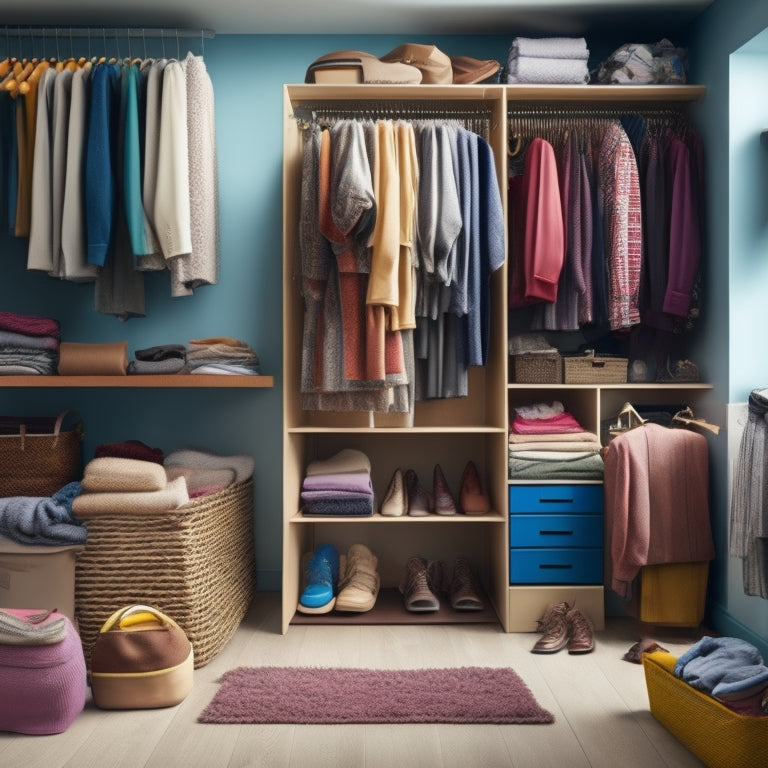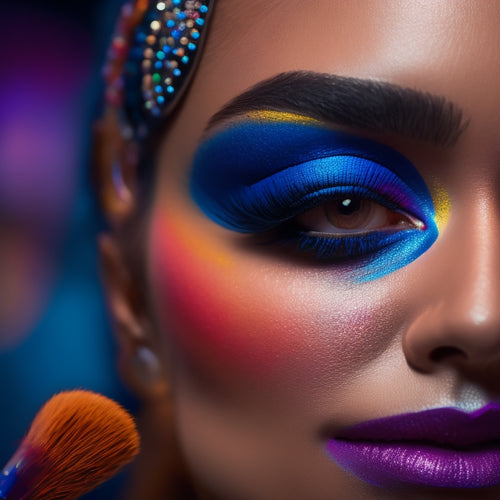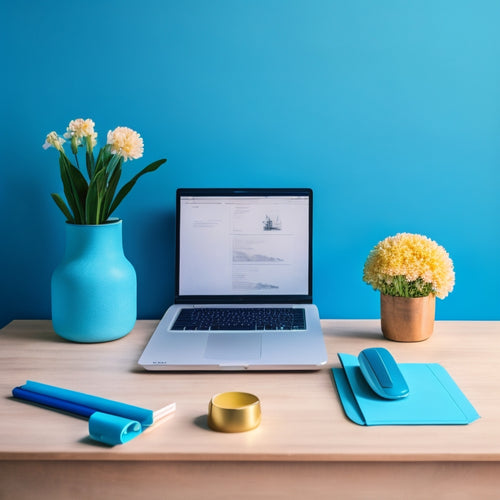
How Do I Organize My Wardrobe With Adhd?
Share
You're ready to tackle your wardrobe chaos with ADHD-friendly strategies! Start by clearing out unwanted items, establishing a morning routine, and setting a productive tone for the day. Then, categorize clothes into groups, simplify your closet structure, and utilize storage containers effectively. Consider color-coding your clothing for easy navigation and visual appeal. Implementing these strategies will help you achieve a more organized wardrobe, and that's just the beginning - there are even more practical tips waiting to help you harness your newfound organizational potential.
Key Takeaways
• Establish a morning routine and clear mindset to prepare for successful wardrobe organization with ADHD.
• Categorize clothes into segments (tops, bottoms, dresses, outerwear, accessories) for easy access and visualization of outfit possibilities.
• Purge unwanted items using the Speed Sorting method and assign a designated home for each item to simplify closet structure.
• Utilize storage containers with labels to maintain structure and ease in finding items, preventing clutter buildup.
• Implement color coding for visual appeal, easy navigation, and reduced decision fatigue when planning outfits.
Prepare Your Space for Success
Clear everything out of your closet and sort items into three piles: keep, donate/sell, and discard, to give yourself a clean slate and a fresh start. This step is vital in organizing your wardrobe with ADHD.
Having a clear mindset is essential in this process. Start your day with a morning routine that sets the tone for a productive day. Then, tackle your closet with a clear head and a willingness to let go of items that no longer serve you.
Categorize Clothes Into Groups
Now that you've prepared your space, it's time to categorize your clothes into manageable groups.
You'll want to start by separating essential items, like undergarments and socks, from the rest of your wardrobe.
Then, group similar styles together, such as all your t-shirts or dresses, to make finding what you need a breeze.
Essential Item Segments
You'll find it helpful to categorize your clothes into essential item segments, grouping similar items together, like tops, bottoms, dresses, outerwear, and accessories. This personalized categorization will help you see what you have and make getting dressed easier.
Here are three essential item segments to get you started:
- Tops:
- t-shirts
- blouses
- sweaters
- Bottoms:
- jeans
- trousers
- skirts
- Dresses:
- casual
- formal
- party dresses
Similar Style Grouping
Within each essential item segment, categorize clothes into groups based on similar styles, such as 'casual weekend' or 'work attire,' to help you visualize outfit possibilities and make dressing easier. This approach can help you create a personal uniform, where you mix and match pieces to create multiple outfits.
| Style Group | Description | Example Items |
|---|---|---|
| Casual Weekend | Comfortable clothes for lounging or running errands | Jeans, sweaters, sneakers |
| Work Attire | Professional clothes for the office or meetings | Suits, blouses, dress shoes |
| Date Night | Dressy outfits for special occasions | Dresses, heels, blazers |
| Activewear | Workout clothes for exercising or athletic activities | Yoga pants, t-shirts, sneakers |
Simplify Your Closet Structure
Now it's time to simplify your closet structure, and you're in control!
You'll start by categorizing your clothing types, which will help you see what you have and what you can get rid of.
Next, you'll quickly purge unwanted items, and then assign a home for each item that's left, making it easy to find what you need.
Categorize Clothing Types
Sort your clothes into broad categories, like tops, bottoms, dresses, outerwear, and accessories, to create a simple and functional closet structure. This helps you see what you have and where it belongs. You'll be more likely to wear what you love and avoid decision fatigue.
Here are three benefits of categorizing your clothes:
-
Effortless outfit creation: With categorized clothes, you can easily mix and match pieces to create new outfits.
-
Streamlined decision-making: You'll spend less time deciding what to wear, as you'll know exactly where to find what you need.
-
Seasonal layers made easy: Categorizing your clothes helps you identify what you need for each season, making it easier to create a personal uniform that works for you.
Purge Unwanted Items Fast
Your newly categorized closet structure is about to get a serious detox, and it starts with you letting go of clothes that no longer spark joy or serve a purpose.
It's time to purge unwanted items fast! Use the Speed Sorting method to quickly sort clothes into three piles: keep, donate/sell, and discard.
Be honest with yourself - if you haven't worn it in a year, it's likely time to let it go. Don't let emotional attachment hold you back.
Remember, the goal is to create a functional, stress-free space that sparks joy.
Take a deep breath, and let the purging begin! You got this!
Assign Home for Items
With your newly purged closet, it's time to designate a home for each item, ensuring everything has a designated spot that makes sense and is easy to maintain. This will help you develop a routine and make the most of your space.
Here are three essential steps to assign a home for your items:
-
Create designated zones: Divide your closet into sections for tops, bottoms, dresses, and outerwear. This will help you find what you need quickly and prevent clutter from building up again.
-
Set up personalized stations: Designate areas for accessories, like a jewelry station or a scarf organizer, to keep similar items together.
-
Use storage containers: Labelled bins and baskets will help keep items like socks, underwear, and accessories organized and out of sight.
Use Storage Containers Effectively
Designate a specific container for each type of clothing to maintain a sense of structure and ease in finding what you need. This will help you stay organized and focused.
Use a label maker to identify what's inside each container, so you can quickly spot what you're looking for.
When choosing containers, consider their sizing - you'll want ones that fit your clothing items snugly, without being too cramped or too spacious. This will help prevent clutter from building up again.
Color Code Your Clothing
Sorting your clothes by color is an efficient way to create a visually pleasing and easily navigable wardrobe, allowing you to quickly identify and locate the perfect outfit. This technique is especially helpful for individuals with ADHD, as it provides a sense of organization and structure.
By grouping similar hues together, you'll create a Rainbow Organization that's both aesthetically pleasing and functional.
Here are three benefits of color coding your clothing:
-
Easier outfit planning: With similar colors grouped together, you can easily mix and match pieces to create new outfits.
-
Reduced decision fatigue: By narrowing down your options to a specific color palette, you'll spend less time deciding what to wear.
-
Monochromatic chic: A color-coded wardrobe makes it easy to create stylish, monochromatic outfits that exude sophistication and style.
Implement the One In, One Out Rule
You've optimized your wardrobe with a rainbow of colors, now it's time to maintain this new order by implementing the one in, one out rule to prevent clutter from building up again. This rule is simple: for every new piece of clothing you bring into your wardrobe, remove or donate an old one. This maintains a balanced amount of clothing and prevents Closet Chaos.
| In | Out |
|---|---|
| New trendy top | Old, worn-out shirt |
| Fashionable jeans | Ill-fitting, outdated pants |
| Comfy sneakers | Worn-out, smelly shoes |
| Timeless coat | Outdated, unfashionable jacket |
Create a Maintenance Routine
To keep your newly organized wardrobe on track, set aside a specific time each week, like Sunday evening or Monday morning, to tackle a quick 10-15 minute maintenance routine. This daily habit will help you stay on top of your wardrobe organization.
Here are three simple tasks to include in your maintenance routine:
-
Put away items that are out of place, like a shirt that's been sitting on the floor for days.
-
Hang up clothes that are wrinkled or out of order.
-
Remove items that are no longer needed or don't fit.
Utilize Double Rods and Shelves
Maximize your closet space by installing double rods, which instantly doubles your hanging capacity and allows you to organize clothes by type, season, or frequency of use. This simple upgrade enables you to optimize your layout, making it easier to find what you need when you need it.
By utilizing double rods, you can separate your clothes into distinct categories, such as tops, bottoms, and dresses, or group similar items together. This system helps you maximize storage and reduces clutter.
Additionally, consider adding shelves to store folded items like sweaters, jeans, or blankets. This will help keep your closet floor clear and make the most of your available space.
Make the Most of Vertical Space
By incorporating stackable storage units or hanging organizers that make use of your closet's vertical space, you can access additional storage capacity without sacrificing floor space. This is especially important when dealing with ADHD, where clutter can exacerbate stress and anxiety.
Here are some ways to maximize your closet's vertical space:
-
Install shelving units that reach the ceiling to store out-of-season clothes or linens.
-
Optimize racks by using double rods or hanging organizers with multiple tiers.
-
Maximize shelves by using stackable bins or baskets to store accessories or clothing items.
Frequently Asked Questions
How Do I Maintain Focus During Organizing Sessions With Adhd?
To maintain focus during organizing sessions with ADHD, you'll benefit from the Pomodoro technique: work in 25-minute increments, take a 5-minute break. Use time blocking to schedule these sessions, and commit to it, helping you stay on track.
Can I Organize My Wardrobe With a Small Closet Space?
"As you stand before your tiny closet, imagine a treasure trove of style. Optimize your closet layout by utilizing storage hacks like shelves and bins, and maximize space with double rods for doubled-up hanging. Folded clothes can be stashed in baskets, freeing up precious real estate."
What if I Have Sentimental Attachment to Certain Clothing Items?
You struggle to part with sentimental clothing items because they're tied to happy memories, but holding onto them creates emotional clutter. Identify the memory triggers and take a photo of the item, then consider letting it go, keeping only what sparks joy.
How Do I Avoid Decision Fatigue When Choosing What to Keep?
"Ah, the agony of choosing what to keep! You're not alone in this never-ending battle. To conquer decision fatigue, try Clothing Curation: prioritize items that spark joy, and practice Mindful Editing – it's not about keeping everything, but curating what makes you feel fabulous."
Can I Involve a Friend or Family Member in the Organizing Process?
"You can definitely involve a friend or family member as an Accountability Partner, providing Moral Support and helping you stay focused - just make sure to choose someone who's non-judgmental and supportive of your ADHD struggles."
Related Posts
-

7 Essential Training Secrets for Dance Makeup Artists
You're about to discover the secrets to transforming your dance makeup artistry into a thriving online business, wher...
-

Streamline Your Creative Workflow: Artist's Productivity Hacks
You're tired of creative blocks, wasted time, and missed deadlines. It's time to enhance your workflow! Start by prio...
-

Dancers Delight: Stylish Wall Prints Available Now
Dancers Delight offers a curated collection of stylish wall prints that capture the essence of ballet, tap, and jazz,...


